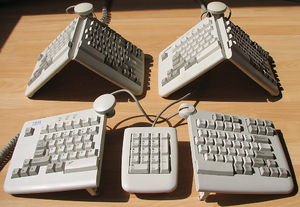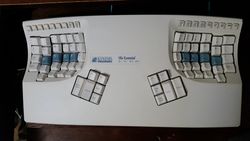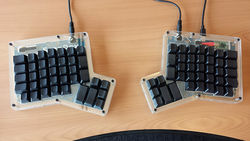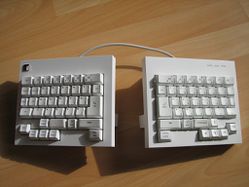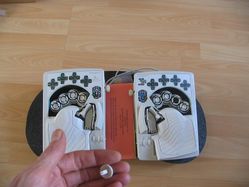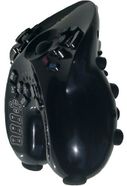Ergonomic keyboard
Ergonomic keyboards are input devices which are proclaimed as being more ergonomic than conventional keyboards in various aspects. They are designed to minimise strains and/or injuries related to hours spent typing, and/or to provide relief to users that have already gained injuries. However, having an ergonomic keyboard does not mean that using one avoids strains and/or injuries: users are always encouraged to also follow best practices in general when using computers.
Ergonomic keyboards became popular in the mid 1990s, and a few ergonomic keyboards from that era are even valuable collectables.
Contents
Features
Like keyboard form factors, there are no standards in terms of what would be defined as ergonomic keyboard except as otherwise explicitly stated by the vendor/manufacturer or otherwise the design differs from the conventional keyboard shape.
Various features listed below by their common names are often proclaimed in research literature and the keyboard community as being "ergonomic" features of a keyboard. Better ergonomic keyboards tend to incorporate multiple "ergonomic" design features, and are often also more adjustable to better cater to different individuals.
Split
A split keyboard has its keys physically separated into two halves: one for each hand. Splitting is a prerequisite to several other features described below.
The term is sometimes used to refer to when the two parts are not physically linked.
Cherry G80-5000 is split with 6 on the left side
Apple Adjustable Keyboard is split with 6 on the right side
All split keyboards assign the letter keys to hands according to the Touch typing school, but there is no consensus about where to split the numeric row: Should 6 be on the left or the right side? On many typewriter-staggered keyboards, such as the Microsoft "Natural Keyboard", the key is on the left. However, if the numeric keys are considered part of columns (which would be natural on a columnar keyboard) the key is on the right side. Very few keyboards, including the Kinesis Evolution, have 6 on both sides.
Tenting
Tenting is having lateral inclination of each half of a keyboard so that if they were together they would resemble a tent. Another term uses the analogue of a house gable: gable angling.
The purpose is to reduce forearm pronation (palms facing down), and to instead get more natural wrist angles (palms more vertical).
Only few keyboards allow the tenting angle to be adjusted freely without steps: examples include the Goldtouch Adjustable Keyboard and the IBM Model M15. Some fully split keyboards tend to allow tenting adjustment using different feet or risers.
More extreme examples have (or can be adjusted into) a fully vertical 90° angle.
Separation and angling
Hand separation means having the left and right hands' parts a distance apart from one-another. Having an opening angle between the halves, means that they are rotated apart around an origin located above the keys.
The purpose of separation/angling is to avoid:
- ulnar deviation — where a wrist is rotated outwards in an unnatural angle, and
- tension in arms and shoulders, by catering to the natural distance between shoulders
There is no standard of where the origin of opening rotation would be located, so the opening angles of different keyboards are not always comparable.
Kinesis Contoured keyboards have fixed hand-separation but no opening angle
Unikey KB-7001 has a fixed opening angle.
By being fully split into two separate halves, ErgoDox allows both hand separation and opening angle to be adjusted
Negative slope
Some keyboards can be sloped forwards ("North") instead of towards the user. This is to make it easier to hold the wrists straight. A negative slope is considered especially suitable when the keyboard is lower than the elbows, such as when standing.
A few keyboards have adjustable feet in the front for this purpose. Some keyboards have retractable legs for this purpose. The Microsoft Natural Keyboard 4000 comes with a detachable riser to place under its front.
Alternatively, there are keyboard trays that can be adjusted to lean forwards.
Hand shape
Some keyboards have the keys physically arranged to better resemble the shape of a hand, at least compared to standard typewriter layout. This is primarily to reduce finger movement, but the keys tend to be also positioned so as to reduce ulnar deviation.
A keyboard with staggered columns has a column for each finger, with the offsets between columns corresponding to the relative lengths of the fingers and/or the position of the knuckles.
The symmetric stagger layout is considered more ergonomic than the standard typewriter keyboard primarily through reducing ulnar deviation, but the columns for the middle, ring and little fingers are offset against each-other somewhat corresponding to the fingers' relative lengths also on both hands.
NEC PC-8801-KI has staggered columns for typing Japanese using the M-system input method
µTRON has columns laid out in a symmetric staggered layout
Note: So called ortholinear keyboards such as the TypeMatrix are an anti-pattern in this aspect, but many ortholinear keyboards are ergonomic in other aspects, such as having hand separation or even being fully split.
Economic layout
Statistics based on text and/or words in a target language have been used to arrange keys so as to minimise the amount of necessary finger movement — relative to a home row.
The most popular such layouts in use may be Dvorak and Colemak. The first ones had appeared in the late 1800's not long after the first typewriter had been invented.
Some keyboards have also purposefully physically omitted the numeric row, so as to minimise finger movement away from the home row. Others have the function keys overlaid on the numeric row, or moved left purposely to avoid having to reach, or to encourage movement of the wrist to avoid strain from holding it static.
Light key switches
Use of lighter key switches could reduce finger strain, but on the other hand a key that is too light would more easily be pressed by mistake. Some keyboards such as the Key Tronic ErgoForce and some variations of the Topre Realforce have variable weighted keys, with the key weight for each key being adapted to the strength of that finger.
If the user can't tell where actuation happens, that could also lead to finger strain. Therefore key feedback is often also considered an ergonomic aspect. Feedback could be in form of tactile feel and/or a click sound, while many users would be content with consistent key feel or a distinct bottoming out after actuation. The Kinesis Contoured has a built-in electronic speaker for keyboard click, which can be turned off.
Other designs
A more unusual category of keyboards that achieve a neutral wrist angle are the backtyping keyboards where the keyboard is held by the sides more like a game controller and the primary keys are on the underside.
Chorded keyboards reduce the number of keys (and thereby finger movement) by instead requiring that multiple keys be pressed simultaneously (as "chords"). Some chorded keyboards produce characters but the more sophisticated ones use chords to represent words — in which case special software is required in the keyboard and/or host to interpret the chords. The latter can be typed very quickly by a trained professional, and are often used for real-time transcription.
The DataHand Professional II is shaped around a hand but does not have regular keys
The Alphagrip iGrip is shaped like a game controller. By having most keys on the bottom, it employs the backtyping concept.
See also
External links
- Deskthority — Ergonomic keyboard parade — Pictures of a multitude of ergonomic keyboards. Posted 2011-03-09. Retrieved 2024-03-20.
- Split Keyboard comparison — Interactive comparison of different split columnar keyboards' layouts. Retrieved 2024-03-20.
- Xah Lee Web — Ergonomic Keyboard Reviews Retrieved 2024-03-20.


